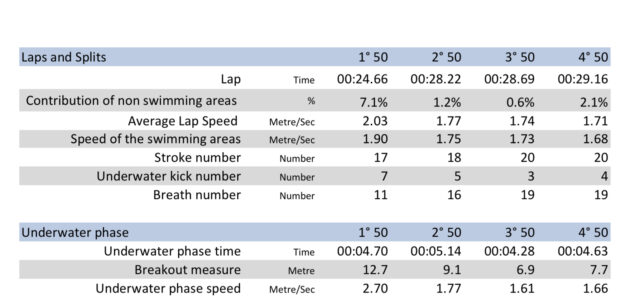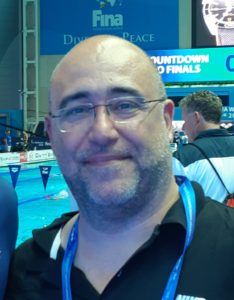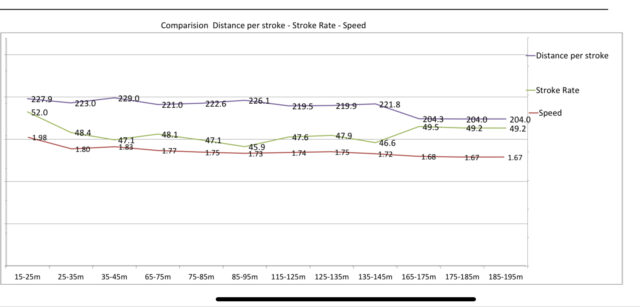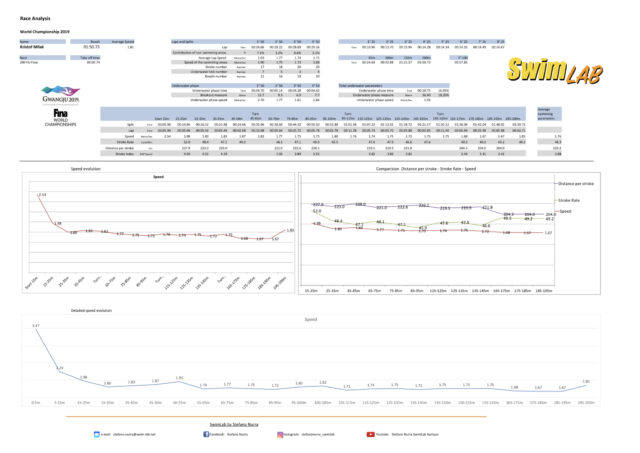By Stefano Nurra
During the 2019 World Championship in Korea, Kristof Milak broke the world record in the men’s 200m butterfly in what was the most stunning swim of the entire event.
In my opinion, thinking about Milak in this race is like thinking about Superman or some other superhero. I was at the meet watching the race and remember the whole arena making a standing ovation just for him, which has only occurred for a few swimmers before.
He destroyed Michael Phelps’ record, swimming an incredible time.
It appears that, in spite of a fairly-severe infection of COVID-19 in the fall, Milak is back on track for Tokyo after another impressive swim of 1:51.40 at the 2021 Hungarian Championships in March.
Analyzing his World Record race from 2019 was amazing, and I tried to gather as much data as possible.
RACE MANAGEMENT
The first point we can see is the race management. the laps for every 50m were:
- 24.66
- 28.22
- 28.69
- 29.16
It was definitely a very aggressive approach, and Milak found himself second after the first 50 meters.
If we compare this race with the men’s 200m free, we can see that the first 50m isn’t very different. Milak’s first 50 split in the 200 fly would have been 4th-best in the final of the men’s 200m free in Gwangju at the World Championships.
The rest of the race is obviously different. In a 200m fly the energy cost used is different compared to the 200m free.
STROKE RATE
Kristof Milak is very consistent in the stroke rate. He has just a minor difference between the start and finish of the 200 meters, but nothing too drastic.
Checking the distance per stroke, we can see that in the first 50m he manages to cover more ground, 226.7cm on average.
In the second and third leg he loses about 3 cm per length: 223.2 cm in the second 50 and 220.4 cm in the third 50. The last 50m show us a significant decrease in the distance per stroke average, 204.1 cm. Therefore, there is a close relationship between the distance per stroke and the lap time.
STROKE COUNTS
I think this is a good opportunity to talk about the stroke counts. This parameter is easy to use in practice but unfortunately doesn’t show the whole story.
If we compare this parameter with the distance per stroke, we can observe that the stroke count for the third 50m and last 50m is always 20 but the distance per stroke was notably different.
UNDERWATER PHASE
This difference will make more sense if we evaluate the length of the underwater phase.
In the third 50m the underwater phase is 6.9 meters long, meanwhile in the last 50m the underwater phase is 7.7 meters long. This explaining the difference in the distance per stroke but the same stroke count in both 50m stints. So, if we want to use the stroke count parameter during a training session, we need to be sure the underwater phase is always the same.
The first 50 is made up of 17 strokes and 12.7 meter underwater; the second 50m is characterized by 18 strokes and an underwater phase of 9.1 meters.
In the underwater phases it’s interesting to see the amount of dolphin kicks each time:
- 7 in the 1st
- 5 in the 2nd
- 3 in the 3rd
- 4 in the 4th
ENERGY MANAGEMENT
In an event like the 200m fly energy management is essential to putting up good times. This is an individual balance that every athlete interprets in a different way.
Some people start faster, some use a higher stroke rate, while others tend to focus on the distance per stroke.
We have seen many different stroke techniques and energy management tactics and it’s important for each athlete to analyze and find out which best suits them. The energy cost of the underwater phases, connected with the speed and length of them, is one of the most important parameters.
Comparing Kristof Milak and Michael Phelps we can see that they have two very different approaches when taking on the 200 fly.
Phelps took a great advantage in the underwater phase with long powerful underwaters, while Milak is much faster in the swimming phase.
TURN’S SPEED
If we check the speed evolution during the race, we can see that the only weak point of Milak’s performance is the speed of the turns.
You can compare the speed between the swimming phase and the underwater phase by calculating the speed from the 5 meters before the turn to the 15 meters after the turn.
In Milak’s case the difference between the two phases is very small, meaning Milak doesn’t gain very much from the turns.
If we check the graph representing the speed from 5 meters before the wall to 15 meters after the wall, we can see that in the first two turns Milak’s underwater phase is slower than his swimming phase and in the last turn the speeds are almost the same.
This means Milak can improve a lot in the underwater phase so maybe we will see Milak improve his times by large margins.
BREATH COUNT
The last point I would like to highlight is the breath count:
- 11 in the first 50m
- 16 in the second one
- 19 in both the third and fourth 50m.
We have already seen the stroke counts: 17 in the first 50m, 18 in the second one, 20 in both third and fourth. This data confirms the point about the balance between energy cost and the speed of every phase of the race.
Breathing, from the metabolic point of view, is extremely important to swim a good 200 fly. This could seem odd for some young coaches, who usually tell young swimmers to not breathe very often.
This suggestion to minimize breathing is correct when speaking about the 100m butterfly and especially the 50m butterfly. This is because it’s important to not change the body position when swimming butterfly, and breathing can alter it.
For the 200m fly we cannot recommend the same technique.
The swimmer must breathe.
So, over time a swimmer must learn to breathe correctly, without changing the body position, and then apply this breathing technique even in moments of fatigue. In the 200-meter butterfly, breathing is essential but the swimmer must be able to keep the same body position.
THE VIDEO ANALYSIS
Thanks to Kristof Milak and to his coach Attila Selmeci, for the lesson and the opportunity to talk about the world record race and the techniques used to swim the 200m butterfly.
This story comes courtesy of STEFANO NURRA
- Analyst of Turkish Swimming Federation
- Analyst of Energy Standard




Great job !!
So what’s the reasoning behind doing no breather strokes on the first 50?
It was his kick.
This is how you swim this challenging event. Master class by Milak.
The fourth lap should be similar to the 3rd lap in stroke count and split. In the 200 fly, you get the “piano effect” because fatigue in the arms makes you sink, which makes you more fatigued. So you’ve got to leave plenty in the tank.
Just goes to show you how much you can improve on in swimming.
this is insane level of analysis and I like it!
Attila Selmeci is probably as much the key as anything else. Also, the 200 fl is a mind game. Cseh had the best time in 2016 and swam hard in the finals in Rio, but lacked the mental part – he said it – being relaxed is vital. Milak is best prepared in his head, taking himself seriously just the right amount, you have to approach it with a Zen attitude.
I’d like to thank Stefano Nurra on behalf of coaches across the world for this analysis. I’ve marked out every 226.7 cm (or 2.267m if you’re American) across my pool deck to help my swimmers train a similar distance per stroke. Tonight we will be swimming a drop out set of 50 flys on 1:00 until you either go over 226.7 cm / stroke or are slower than 24.66. For those first swimmers who drop out, I will place an emphasis on GECO (Grace. Empathy. Cheering. Organizational skills.).
Hi Steve,
Disappointed to see you’ve dropped your emphasis on etiquette from the Auburn coach announcement article. I really think this is going to be detrimental for their development, even with that wonderful set you’ve just described. Any chance we can emphasize GEECOS (Grace. Empathy. Etiquette. Cheering. Organizational Skills)?
Best,
PVSFree
Milak’s ankle flexibility looks like a huge asset. You can see him holding a lot of water with his feet, which is something Phelps and Bowman focused on.